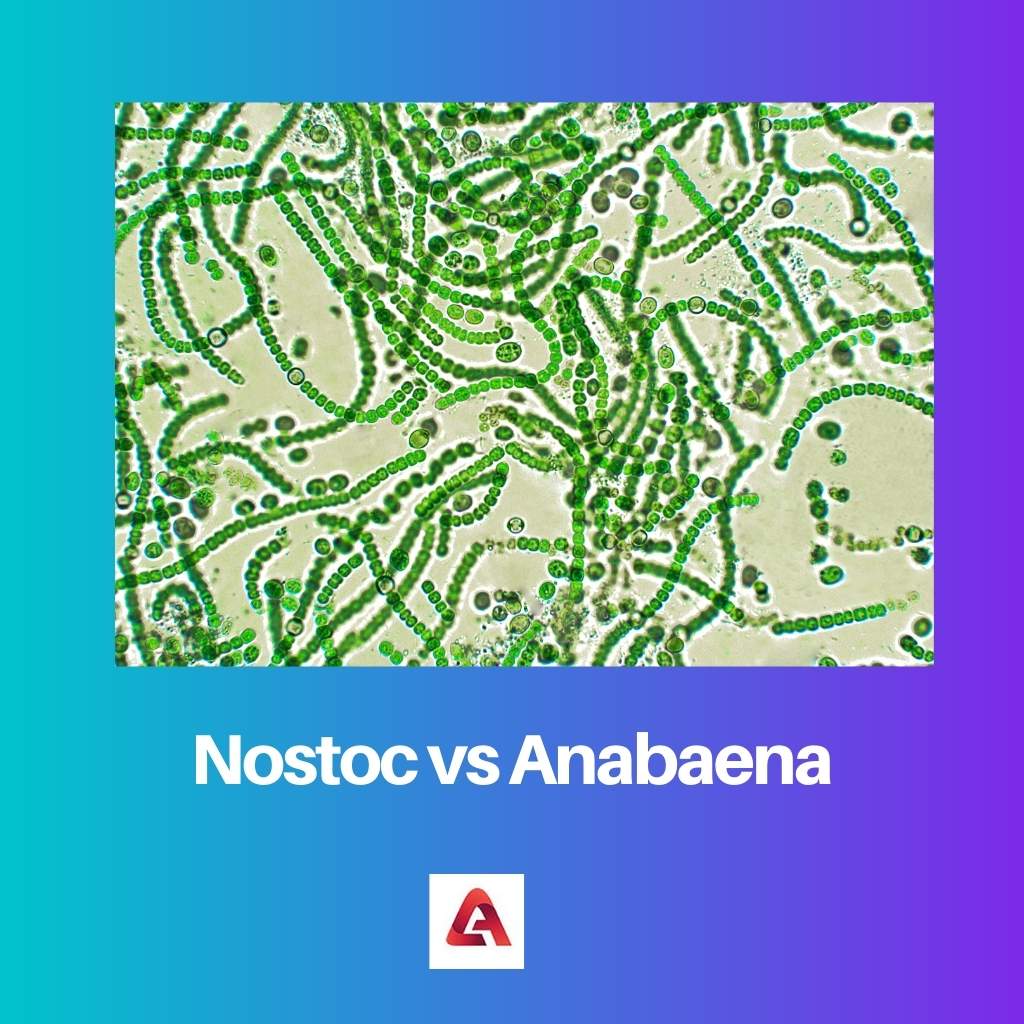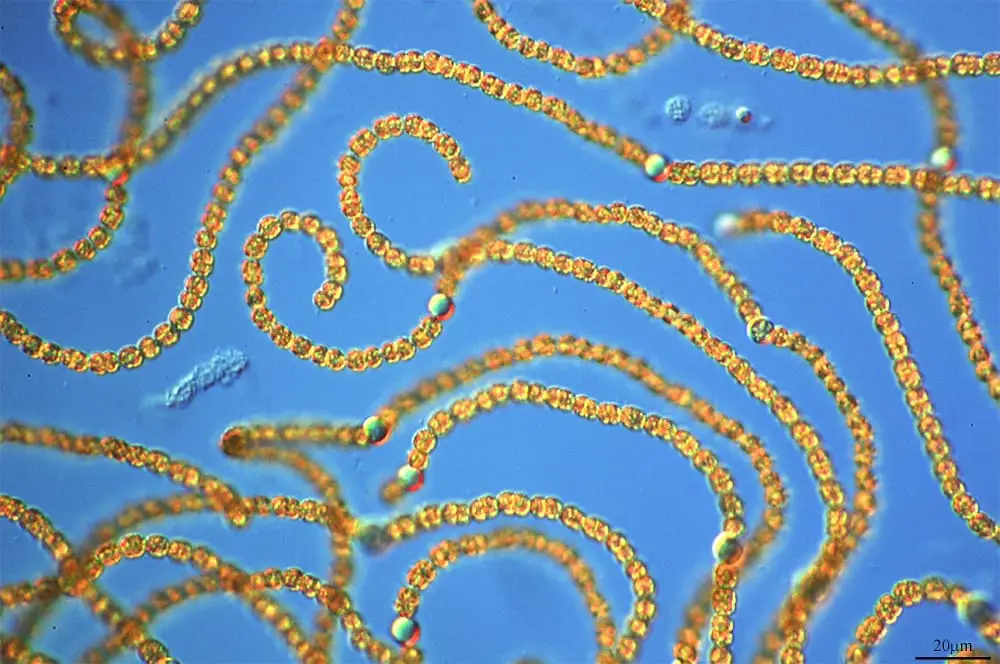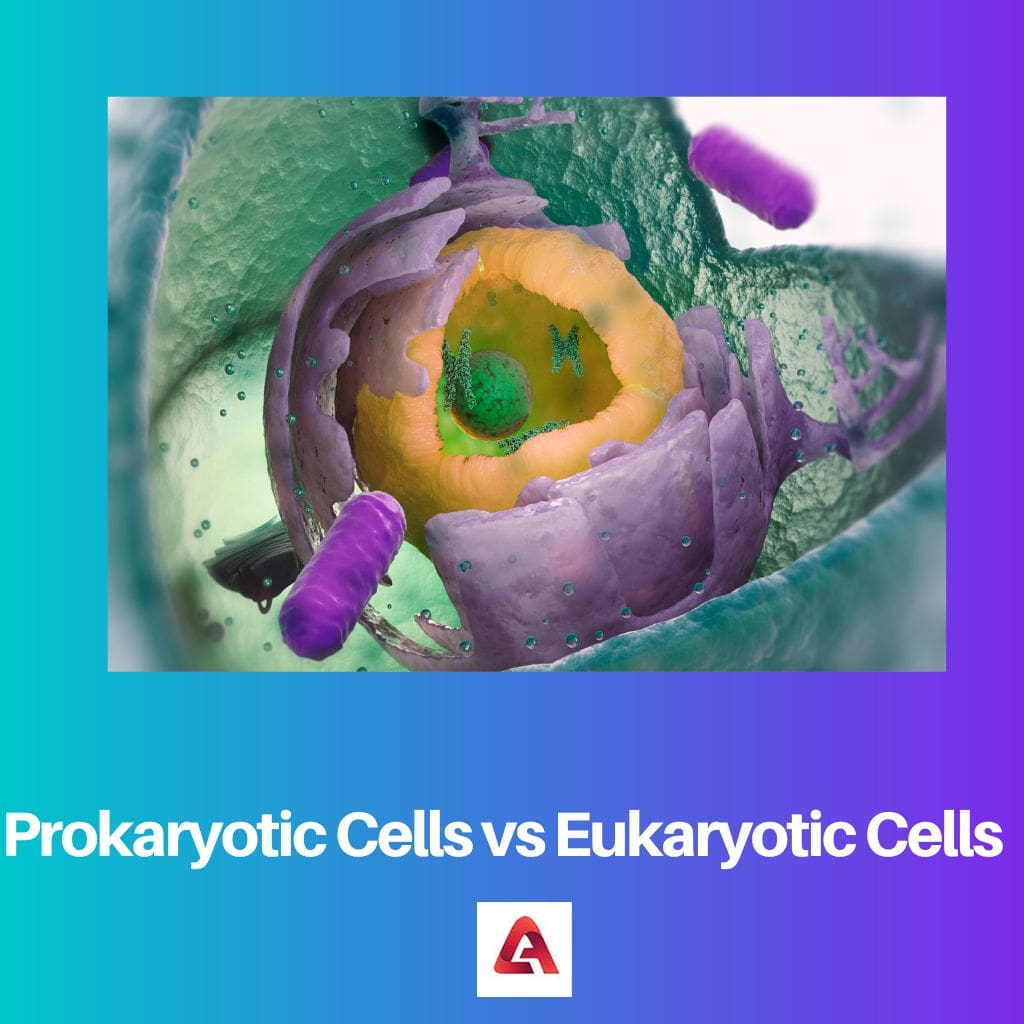In ecosystems, blue-green algae or cyanobacteria are considered important organisms. They are capable of producing their own food by photosynthesizing.
At the beginning of life on Earth, blue-green algae or cyanobacteria were the first organisms that created an atmosphere of oxygen. Nostoc and anabaena are some of the genera of cyanobacteria.
Key Takeaways
- Nostoc is a genus of cyanobacteria that forms colonies, whereas Anabaena is a filamentous cyanobacterium with heterocysts.
- Nostoc colonies can be found in soil or water, while Anabaena is in aquatic environments.
- Nostoc has a slimy texture, while Anabaena does not.
Nostoc vs Anabaena
Nostoc is a class of blue-green algae found in freshwater in free-living colonies and in tree trunks. Its colonies are built in a cylindrical gelatinous sheath. They reproduce by fragmentation. Anabaena is a bacteria under the genus of blue-green algae known for its nitrogen-fixing ability. It is found in water bodies that build straight or coiled filaments.

Nostoc is a genus of blue-green algae or cyanobacteria found in ponds, lakes, damp rocks, or other places. Nostoc forms its colonies in a gelatinous sheath.
The colonies are formed with filaments of moniliform cells. Within the gelatinous sheath, there are many tangled filaments composed of cells. Along the tangled filaments, there are heterocysts.
Anabaena is a genus of filamentous blue-green algae or cyanobacteria. They are known for their amorphous filaments and intercalary heterocysts. Anabaena has the ability to remove nitrogen from the atmosphere.
Anabaena builds endosymbiotic relationships with some plants like mosquito ferns. Some of the Anabaena live within a plant as chloroplasts, using which plants make their foods.
Comparison Table
| Parameters of Comparison | Nostoc | Anabaena |
|---|---|---|
| Definition | Nostoc refers to a genus of blue-green algae or cyanobacteria which form its colonies in a gelatinous sheath. | Anabaena is a genus of filamentous blue-green algae or cyanobacteria which have beadlike filaments in the cells and gives a fishy odor. |
| Habitat | Nostoc is free-living in damp habitats and water bodies like lakes, ponds, damp rocks. | Anabaena builds endosymbiotic relationships with specific plants like mosquito fern. |
| Depth range | Nostoc exists on the surface of the water, soil, and damp areas. | Anabaena exists within one meter of the depth in the aquatic habitats. |
| Morphology | Nostoc builds its colonies in a gelatinous sheath, appearing spherical, ovoid, or cylindrical. | Anabaena builds filaments that are either coiled or straight. |
| Reproduction | The reproduction system of nostoc is either by fragmentation or simply by fission. | The reproduction system of Anabaena is either by akinetes or by trichome fragmentation. |
What is Nostoc?
Nostoc is a genus of blue-green algae characterized by the formation of ovoid, spherical, or cylindrical colonies. The filaments of these colonies of nostoc are situated in a gelatinous sheath.
Nostoc is found in damp habitats and water bodies like lakes, ponds, damp rocks, or other damp places. The reproduction system of nostoc is either by fragmentation or simply by fission.
According to fossils, nostoc is one of the oldest organisms on the Earth, having lived for more than 3.5 billion years.
There are two hundred different species of nostoc, which have colonies in various environments, including some of the world’s inhospitable regions.
The reproduction system of Anabaena is either by akinetes or by trichome fragmentation.
There are both freshwater and saltwater species of nostoc. Nostoc has a protective layer that allows them to live in any environmental conditions like a flood, drought, or an extremely low temperature.
Some of the nostoc species are capable of withstand the thawing cycle and freezing, which helps them to survive in the Antarctic and Arctic.
Nostoc forms symbiotic relationships with some plant tissues like Gunnera, hornworts, and so on.
Nostoc has terminally differentiated heterocysts that are involved in the fixation. For undergoing photosynthesis, the nostoc contains pigments in the cytoplasm.
In Asia, nostoc is consumed as a foodstuff due to the containment of Vitamin C and proteins. The common names for nostoc are witch’s jelly, witch’s butter, troll’s butter, and star jelly.

What is Anabaena?
Anabaena is a genus of blue-green algae or cyanobacteria, which has the ability to nitrogen-fixing. Anabaena has beadlike filaments in the cells and gives a fishy odour.
Anabaena produces akinetes, which are thick-walled, dormant, enveloped, non-motile cells.
Anabaena formed its colonies composed of barrellike or bead-like cells. It is a filamentous blue-green algae and exists as plankton. The cells of Anabaena are not covered with a mucilaginous sheath.
The trichomes or vegetative cells of Anabaena are arranged in chains that are not in a branched formation.
Anabaena forms an endosymbiotic relationship with some plants like rice plants, legumes, and mosquito ferns. In these plants, they produce neurotoxins that are harmful to wildlife.
Anabaena also protects plants from the pressure of gazing. Anabaena is a photosynthetic organism that has the ability of nitrogen fixation.
Anabaena is found in an endosymbiotic relationship with specific plants. Azolla is one of the common water ferns.
By associating with the plant, Anabaena supplies nitrogen to the plant while plants provide carbon for Anabaena. Farmers use Azolla as organic fertiliser for harvesting rice, as Azolla supplies nitrogen in the soil.
Anabaena is a photoautotrophic blue-green algae. It produces its own food by photosynthesis, and during the process of photosynthesis, it generates oxygen in the air.
It can be found in freshwater. It has a fishy odour and taste. It is known for producing neurotoxins.

Main Differences Between Nostoc and Anabaena
- Nostoc refers to a genus of blue-green algae or cyanobacteria which form its colonies in a gelatinous sheath. On the other hand, Anabaena is a genus of filamentous blue-green algae or cyanobacteria, which have beadlike filaments in the cells and give a fishy odour.
- Nostoc is free-living in damp habitats and water bodies like lakes, ponds, and damp rocks. In contrast, Anabaenas builds endosymbiotic relationships with specific plants like mosquito ferns.
- Nostoc exists on the surface of the water, soil, and damp areas. Anabaena exists within one meter of the depth in the aquatic habitats.
- Nostoc builds its colonies in a gelatinous sheath, appearing spherical, ovoid, or cylindrical. On the contrary, Anabaena builds filaments that are either coiled or straight.
- The reproduction system of nostoc is either by fragmentation or simply by fission. The reproduction system of Anabaena is either by akinetes or by trichome fragmentation.





